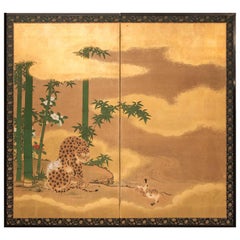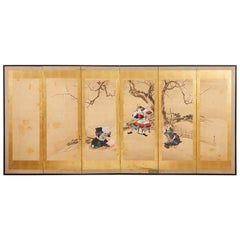Japanese Leopard Screen
Antique Mid-19th Century Japanese Paintings and Screens
Gold Leaf
Antique 19th Century Japanese Edo Paintings and Screens
Brass, Gold Leaf
People Also Browsed
21st Century and Contemporary British Organic Modern Wall Lights and Sco...
Plaster
Mid-20th Century Japanese Showa Paintings and Screens
Silk, Wood, Paint
Vintage 1970s Brazilian Mid-Century Modern Chaise Longues
Leather, Cane, Wood
Antique Mid-19th Century Chinese Qing Paintings and Screens
Silk, Bamboo, Glass, Wood, Paint, Paper
Antique Late 19th Century Japanese Paintings and Screens
Wood, Silk, Paper
2010s Chinese Paintings and Screens
Gold Leaf
Early 20th Century Japanese Taisho Paintings and Screens
Paper
21st Century and Contemporary American Mid-Century Modern Lounge Chairs
Fabric, Wood, Walnut
20th Century Chinese Paintings and Screens
Gesso, Wood
Antique Mid-19th Century Japanese Edo Paintings and Screens
Silver Leaf
Mid-20th Century Japanese Showa Paintings and Screens
Silk, Wood, Paper
Antique Early 19th Century Japanese Edo Paintings and Screens
Gold Leaf
Early 20th Century Japanese Paintings and Screens
Gold
Antique 18th Century Japanese Edo Paintings and Screens
Gold Leaf
Antique Early 19th Century Japanese Edo Paintings and Screens
Gold Leaf
Antique Early 19th Century Japanese Edo Paintings and Screens
Gold Leaf
Finding the Right paintings-screens for You
Traditional Asian paintings were often created on scrolls and folding screens. Artisans made screens that could be folded up or spread out by connecting several panels using hinges. Today, antique Asian folding screens and paintings are sophisticated decorative accents that can serve as makeshift partitions to ensure privacy.
The original folding screens were created by Chinese artists. The earliest record of screens comes from the 2nd century B.C., and surviving examples date back to the Ming dynasty. Chinese painting utilizes many of the same tools as calligraphy — these screens were crafted from wood with painted panels featuring striking art or calligraphy that told cultural stories or represented nature and life in the area.
The practice was introduced to Japan, where paintings for screens were made on paper and silk, in the 8th century. These paintings frequently feature subjects such as landscapes, animals, flowers and Buddhist religious themes. Along with screens for tea ceremonies and dance backgrounds, there were screens for use in Shinto and Buddhist temples.
In the 17th century, screens began to be imported to Europe where their popularity grew. Coco Chanel famously collected Coromandel folding screens.
Traditional Asian paintings can make a tasteful addition to any wall, and screens can be used as decoration or, in the case of larger iterations, as an aesthetic way to divide a large room. Browse the selection of antique Asian paintings and screens from a variety of styles and eras on 1stDibs.
- 1stDibs ExpertAugust 17, 2021Japanese screens are called Byōbu and are made from many panels with beautiful calligraphy and paintings. These folding screens can be a decorative and interesting way to separate rooms in a living space. Find a collection of Japanese screens for sale on 1stDibs.
- 1stDibs ExpertApril 5, 2022Japanese screen painting is the art of creating byōbu, or Japanese screens. Byōbu vary in subject matter and style. The screens are free-standing, portable and decorated with symbolic images or calligraphy. It is common to find byōbu in pairs with at least two panels. Shop a selection of byōbu on 1stDibs.
 Lotus GalleryMarch 17, 2021A Japanese low screen was traditionally used while seated upon the floor. The low screen would block wind and drafts, provide limited privacy, and are often decorated with seasonal themes.
Lotus GalleryMarch 17, 2021A Japanese low screen was traditionally used while seated upon the floor. The low screen would block wind and drafts, provide limited privacy, and are often decorated with seasonal themes.
Read More
Chicago’s Pagoda Red Has a Spirited Mix of Asian Antiques and Bold New Art
For 25 years, gallerist Betsy Nathan has leveraged her keen eye and key connections to bring a unique selection of rare finds to the market.
In L.A., Gallerist JF Chen Has Long Championed Eclectic Blue-Chip Design
Now working alongside his daughter Bianca, dealer Joel Chen has presented a most covetable array of antiques, art and contemporary creations for more than 40 years.
12 Calming Spaces Inspired by Japanese Design
From cherry-blossom-adorned walls paired with glamorous lighting to wood-paneled ceilings above checkerboard-patterned chairs, these 12 spaces seamlessly blend Eastern and Western aesthetics.
Rodrigo Rivero Lake’s Mexico City Showroom Is a Museum-Worthy Trove of Spanish Colonial and Asian Antiques
The dealer and curator has spent the past 50 years amassing a collection of exceptional art, furniture and architectural elements that trace the cultural influence of the Spanish empire from Europe to the Americas and beyond.
16 Refined Asian-Inspired Interiors
These spaces exemplify how Eastern elements elevate a home's decor.



